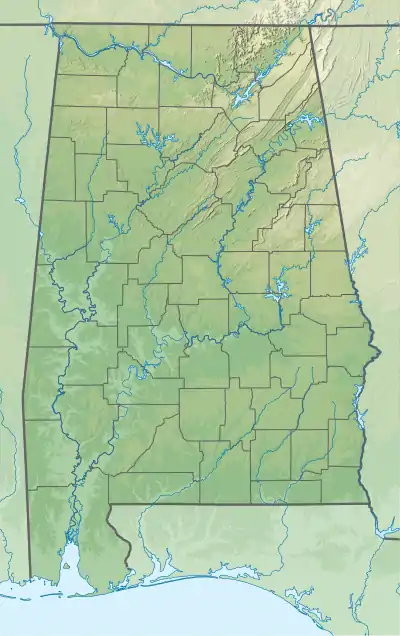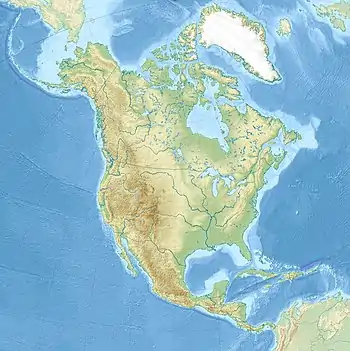Hatchetigbee Bluff Formation
The Hatchetigbee Bluff Formation is a geologic formation in Alabama, Georgia, Louisiana and Mississippi. The youngest unit of the Wilcox Group preserves fossils dating back to the Ypresian stage of the Eocene period, or Wasatchian in the NALMA classification.[1] The formation is named for Hatchetigbee Bluff on the Tombigbee River, Washington County, Alabama.[2]
| Hatchetigbee Bluff Formation Stratigraphic range: Ypresian (Wasatchian) ~55–50 Ma | |
|---|---|
| Type | Formation |
| Unit of | Wilcox Group |
| Sub-units | Bashi Member |
| Lithology | |
| Primary | Marl, sandstone |
| Other | Shale, siltstone |
| Location | |
| Coordinates | 31.3°N 86.1°W |
| Approximate paleocoordinates | 33.1°N 71.7°W |
| Region | |
| Country | |
| Extent | Gulf of Mexico Basin |
| Type section | |
| Named for | Hatchetigbee Bluff, Tombigbee River, Washington County, Alabama |
| Named by | Smith & Johnson |
| Year defined | 1887 |
 Hatchetigbee Bluff Formation (the United States)  Hatchetigbee Bluff Formation (Alabama) | |
Wasatchian correlations
| Formation | Wasatch | DeBeque | Claron | Indian Meadows | Pass Peak | Tatman | Willwood | Golden Valley | Coldwater | Allenby | Kamloops | Ootsa Lake | Margaret | Nanjemoy | Hatchetigbee | Tetas de Cabra | Hannold Hill | Coalmont | Cuchara | Galisteo | San Jose | Ypresian (IUCS) • Itaboraian (SALMA) Bumbanian (ALMA) • Mangaorapan (NZ) |
|---|---|---|---|---|---|---|---|---|---|---|---|---|---|---|---|---|---|---|---|---|---|---|
| Basin | Powder River Uinta Piceance Colorado Plateau Wind River Green River Bighorn | Piceance | Colorado Plateau | Wind River | Green River | Bighorn | Williston | Okanagan | Princeton | Buck Creek | Nechako | Sverdrup | Potomac | GoM | Laguna Salada | Rio Grande | North Park | Raton | Galisteo | San Juan | ||
| Country | ||||||||||||||||||||||
| Copelemur | ||||||||||||||||||||||
| Coryphodon | ||||||||||||||||||||||
| Diacodexis | ||||||||||||||||||||||
| Homogalax | ||||||||||||||||||||||
| Oxyaena | ||||||||||||||||||||||
| Paramys | ||||||||||||||||||||||
| Primates | ||||||||||||||||||||||
| Birds | ||||||||||||||||||||||
| Reptiles | ||||||||||||||||||||||
| Fish | ||||||||||||||||||||||
| Insects | ||||||||||||||||||||||
| Flora | ||||||||||||||||||||||
| Environments | Alluvial-fluvio-lacustrine | Fluvial | Fluvial | Fluvio-lacustrine | Fluvial | Lacustrine | Fluvio-lacustrine | Deltaic-paludal | Shallow marine | Fluvial | Shallow marine | Fluvial | Fluvial | |||||||||
| Volcanic | Yes | No | Yes | No | Yes | No | Yes | No | Yes | No | ||||||||||||
See also
- List of fossiliferous stratigraphic units in Alabama
- List of fossiliferous stratigraphic units in Georgia (U.S. state)
- List of fossiliferous stratigraphic units in Louisiana
- List of fossiliferous stratigraphic units in Mississippi
- Paleontology in Alabama
- Paleontology in Georgia (U.S. state)
- Paleontology in Louisiana
- Paleontology in Mississippi
References
Bibliography
- Sessa, J. A.; T. J. Bralower; M. E. Patzkowsky; J. C. Handley, and L. C. Ivany. 2012. Environmental and biological controls on the diversity and ecology of Late Cretaceous through early Paleogene marine ecosystems in the US Gulf Coastal Plain. Paleobiology 38. 218–239.
- Dockery, D. T. 1980. Invertebrate Macropaleontolgy of the Clarke County Mississippi Area. Bulletin - Mississippi Geological, Economic and Topographic Survey 122. ..
- Hansen, T. A. 1978. Ecological control of evolutionary rates in Paleocene - Eocene marine molluscs - Ph.D. thesis, 1–310. Yale University.
- Toulmin, L. D. 1977. Stratigraphic Distribution of Paleocene and Eocene Fossils in the Eastern Gulf Coast Region. Geological Survey of Alabama, Monograph 13. 1–602.
- Palmer, K. V., and D. C. Brann. 1965. Catalogue of the Paleocene and Eocene mollusca of the southern and eastern United States. Part 1. Pelecypoda, Amphineura, Peteropoda, Scaphopoda and Cephalopoda. Bulletins of American Paleontology 48. 1–471.
- Aldrich, T. H. 1921. New Eocene species from Alabama. Bulletins of American Paleontology 9. ..
Further reading
- Smith, E.A., and Johnson, L.C., 1887, Tertiary and Cretaceous strata of the Tuscaloosa, Tombigbee, and Alabama Rivers: U.S. Geological Survey Bulletin, 43, 189 p.
This article is issued from Wikipedia. The text is licensed under Creative Commons - Attribution - Sharealike. Additional terms may apply for the media files.
